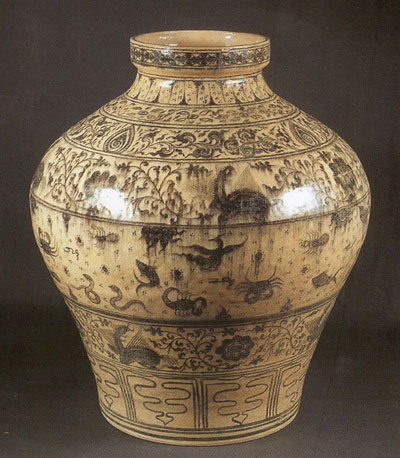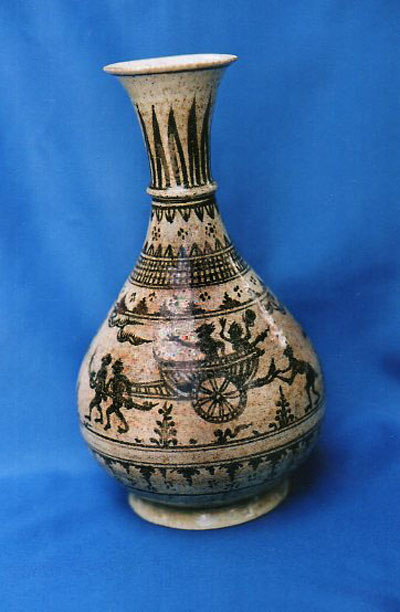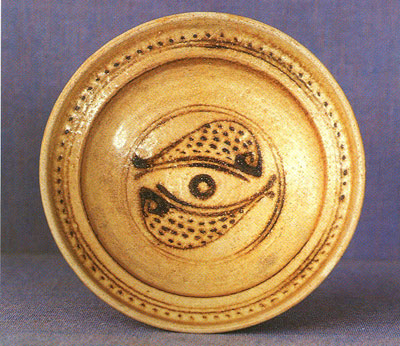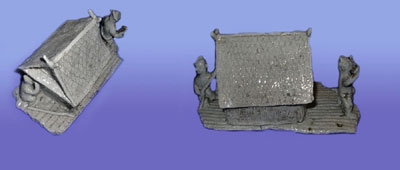|
When I was in the south of Thailand, I had a chance to visit a Thai Muslim government official who collected antiques at his house in Narathiwas province. There I found a long sword engraved with the letters VK. It is said to be the sword of a Viking. I also found old plates and pots with big and small barnacles. There were some old Chinese patterns such as animals and flowers. The colors were pale and the drawing was quite charming. My thought at that time was about the other side of the man who was the collector. He said he got them from the gulf of Thailand and claimed that they were treasures from Chinese merchants who came to trade for food and spice in the Sukhothai dynasty period (14th to 16th centuries).
Patterns such as a flying crown and a floral or vine-like pattern reminded one of the style of Lanna empire pottery we can see everywhere when we are in Northern Thailand, flowers with thick petals and colors of the pottery from the Thai gulf. The source would be the clay and kilns of the North.
There were occasions that people of that time tried to transport this pottery to other countries but many ships were lost at sea. Long after, people found the pottery in the Thai gulf, encrusted with barnacles and the shells of other sea creatures. They were in remarkably good condition and are now priceless.
Pattern of double fish, big birds with long necks and animals in literature called "flying kirins", elaborate cloud formations, and a variety of abstract figures— everything so familiar to me because of my interest in the past.
This is an occurence which can be found in woodcarving and silverware in the North, including a replica of Buddha's footprint in a museum in the north of Thailand. The inherited art became the form of culture. Actually, the Art of China is very influential because it is considered to be an archetype.
The earliest wares were produced at Ban Ko Noi, Sisatchanalai district, Sukhothai province Thailand. Mon kingdoms ruled large sections of Burma from the 9th to the 11th, the 13th to the 16th, and again in the 18th centuries. The first recorded kingdom that can indisputably be attributed to the Mon people was Dvaravati, which prospered until around 1000 AD when their capital was sacked by the Khmer Empire and most of the inhabitants fled west to present-day Burma and eventually founded new kingdoms. These, too, eventually came under pressure from new ethnic groups arriving from the north.

The higher quality celadon is glazed with simple to intricate incise designs and are dated to the 14th to 16th centuries (about 500-600 years ago). I used to see a tripod lantern in cream color with lamp oil. The design was a geometric shape. How fantastic!
Ka Long pottery is made and related to the kings and wars or religions such as the making of the war elephant of the king and his troops. For Hinduism purposes, there were the ceramics of the four-armed Ganesha which held different weapons in each hand. There were many bracelets, armbands, and ankle bands, but the Buddha image from ceramics in the Northern style look like Chiang san or Burmese wooden sculpture, the form of ceramic from the Wieng Kalong Kiln. The creations in this period portray elephants, horses, oxen and buffaloes. It is believable that the Chinese artisans taught local people to make ceramics in the area of finest quality clay called Wiang Kalong. After burning the clay, the color becomes light yellow or cream or gray. Apart from the old pottery of Lanna Empire in forms for religions, lifestyle, war and animals, there were local musical instruments and even an amorous couple in an interesting complex position. We can understand that the lifestyle at that time was amusing and independent which meant that artists had opportunities to use nature as a model with no restriction.

The outstanding characteristics of San Kamphaeng ware was a coarse clay, low footrim, a white slip painted on the mouth rim and on the interior before glazing or decorating. The most popular decorative design, which became typical of San Kamphaeng ware, was that of twin fish, similar to the Chinese Yin and Yang symbol, swimming on the bottom. Ware were found that used the underglazed black decorated dishes and the spectacular large dual glazed jars.
Phan ware was produced at kilns in Pong Daeng and Mai Nong Phak Jik Village in Sai Khao saubdistrict of Phan District in Chiang Rai Province. The characteristic shape of the ceramic ware was not distinct from that of the ceramic ware from the Wiang Ka Long kilns. But the glazing was done with a celadon glaze like that on celadon ware. One difference is that no Phan ware have underglazed black designs when they were produced.
Early local archaeologists called the ceramic wares that were produced from Wiang Tha Kan kilns "Late Haripunjaya bottles". They believe the origin could be at Lumphun Province according to previous data that had recorded the excavation at the Haripunjaya historical sites, and other hilltop burial sites in Tak Province. At present, the new generation of archaeologists has discovered new evidence near the ancient city of Wiang ThaKan in San Patong District of Chiang Mai Province.

The characteristic shapes of bottles that have been found is now what Thai people in the northern part of Thailand call " Nam Ton". A bottle with shapes that are the same as the bottle shapes of Sukhothai wares. The unique characteristics of these bottles, were their orange fine clays due to being finely potted. They were decorated by carving with the white slips or painting with black colors so they had many styles of decoration such as zoomorphic and flower patterns. The main purpose of Wiang Tha Kan wares was to contain water more than containing the remains of the dead people. Thus the dating of Wiang Tha Kan ware could be early to late 14th century, during the reign of King Meng Rai of LannaKingdom.
From the history of the three kings from Sukhothai empire King Ram Kamheang, King Mengrai of Lanna Kingdom, and King Ngammuang from Prayao: The three Kings promised to be friends. People grew rice and worked with Klins and ceramic ware in an era of creation and use for trade. It was a significant part of the wealth of Suwanaphumi at that time .

We also saw statues of villagers hold fighting cocks in one hand along with Pod Duang (Money) in another hand. They also depicted leisure rafting for lovers, the amusement of artisans from 500 years ago..
The art of living in many forms in ancient Thailand reveals much about their way of life. .
Photos : Fine Thai Ceramics from Mekdhanasarn Museum
|
